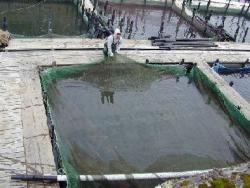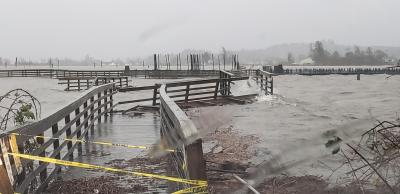
The net-pen system is a surprisingly simple but leading-edge approach to reviving salmon populations in the Youngs Bay estuary and other "select" areas where native stocks have been depleted.
How it works!
The Fisheries Project operates three estuarine net-pen sites in Youngs Bay, Tongue Point, and Blind Slough and a hatchery and rearing pond on the South Fork of the Klaskanine River, a tributary to Youngs Bay. In the fall or early spring, juvenile salmon are brought to the net pens, where they are reared by the project staff until ready to be released to migrate to the ocean (anywhere from two weeks to six months in the net pens).
A small-mesh net is suspended from a floating frame, made of high-density polyethylene pipe, that is secured to pilings. Each side of the pen is 20 feet long. The net hangs 10 feet deep. The pens were designed by Fisheries Project staff and are made by Ferguson Enterprises of Washougal, Washington, the company that built the pen for the orca Keiko in Iceland.
Chinook and coho fingerlings from the Oregon Department of Fish and Wildlife and U.S. Fish and Wildlife hatcheries are placed in the net pens. The fish are raised in these pens for various lengths of time, long enough for them to "smolt," a physiological change prior to entering saltwater.
The Fisheries Project also collects and receives eggs for incubation at its hatchery on the South Fork of the Klaskanine River.





